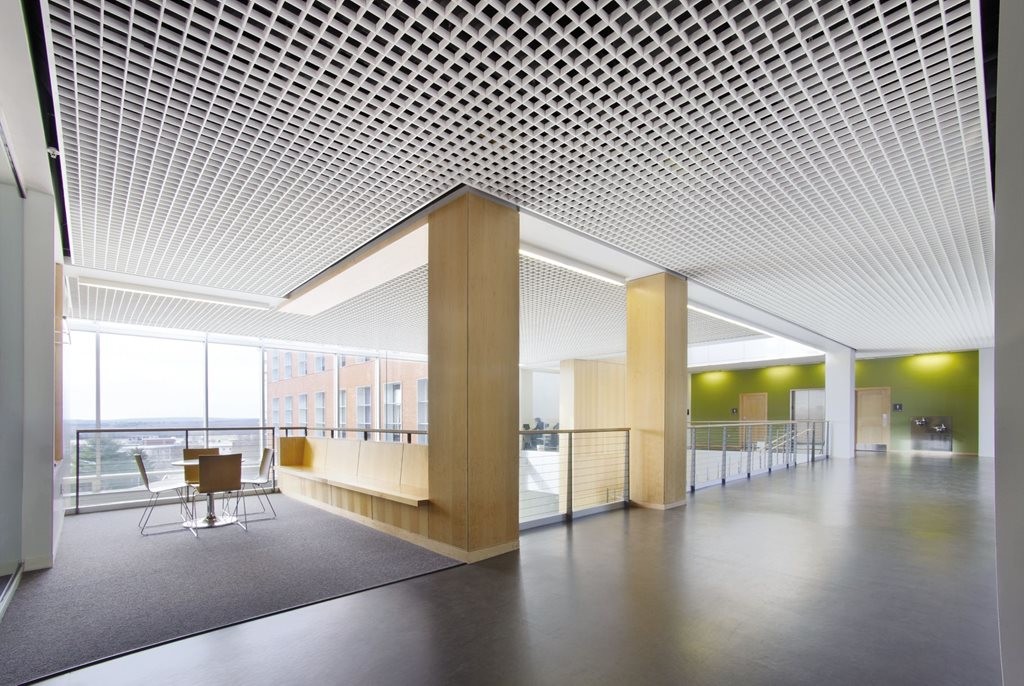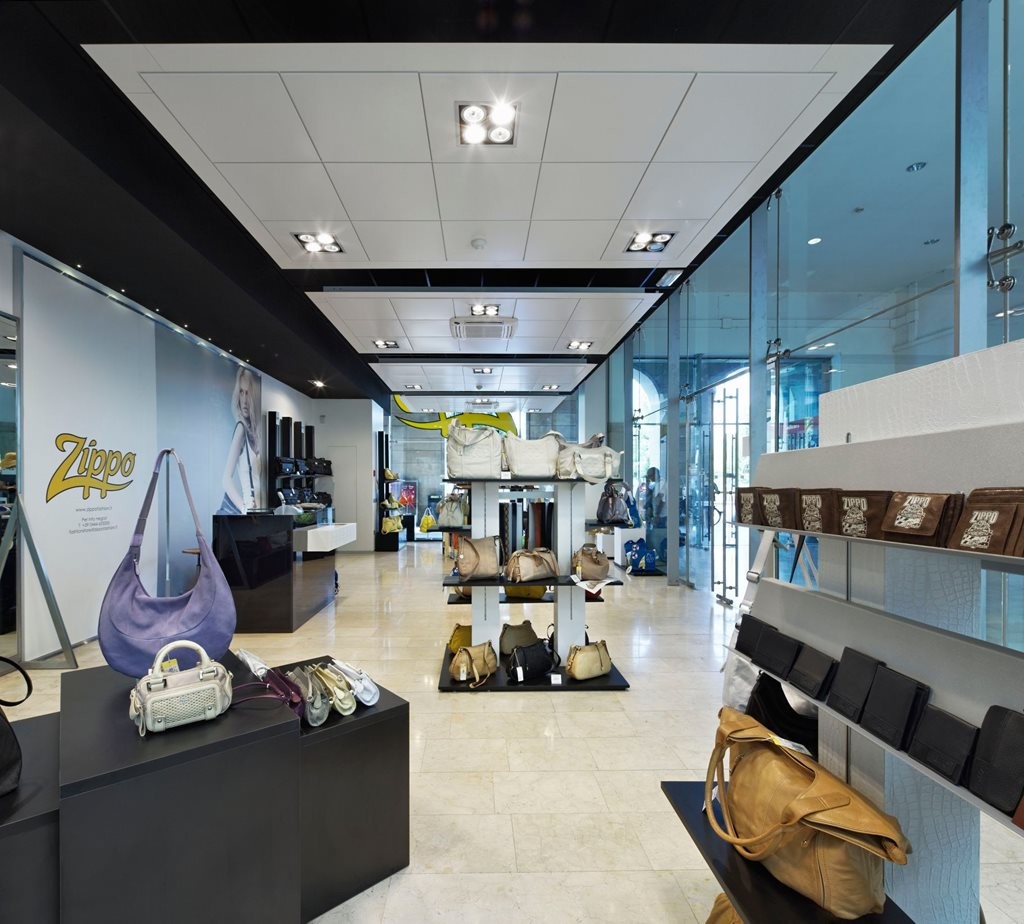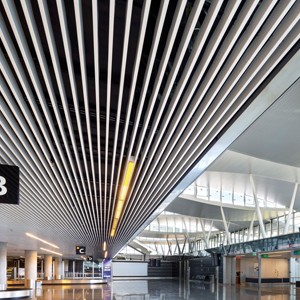This article is Part Four in a series of metal ceiling tile articles looking at the advantages of the product through a variety of applications. Part One explored an architect’s perspective at the Darling Quarter project in Sydney. Part Two threw questions at a ceiling expert and unveiled the specific uses and limitations of metal ceiling tiles. In Part Three we went back to an experienced specifier armed with new questions to gain further insight into why metal pan ceiling tiles are a superior to other products.
“There are hundreds of variations of metal pan ceiling tiles that can be achieved,” says Paul Cootes from Como Building products.
“But to keep it simple it’s easier just to work from three main types of grid systems and then you can differentiate with how individual ceiling tiles attach to that grid.”
The three systems Cootes refers to are the clip-in, hook-on and lay-in varieties, all of which differ in the way they attach to a ceiling grid and also in the finish and functionality they can achieve.
These grid systems are also used with other types of ceiling tiles such as mineral fibre but due to their composition, a metal pan ceiling can achieve different shapes and finishes that non-metal varieties cannot.
Following is a list of the types of grids and their most suited applications. More importantly the list will describe ways you can utilise metal pan with that associated grid to take your ceiling to places unseen in non-metal applications.
1. LAY-IN TILE:


Above ceiling tiles lay on a T-shaped runner such as top-left. Right: NAB Docklands building utilises a perforated metal lay-in tile system.
The grid of a lay-in tile system is fully seen and is the most common product in standard office buildings.
Tiles are simply placed on a T-shaped runner (above left), generally between 10 and 25mm, and can be easily installed and demounted as individual tiles.
Cootes drew attention to the flexibility that lay-in tiles afford to maintenance requirements and services that need to access the ceiling void above the tiles.
“Lay-in tiles are extremely easy to remove and flexible for services such as electricians, plumbers, aircondition and that sort of thing,” he said.
“They are also the easiest to move around when renovating and shifting office spaces.”
Applications:
-
Offices, places that require consistent maintenance, buildings with chilled beam systems such as the above NAB Docklands building by Woodsbagot. (Image: Armstrong)
-
Without perforations they are also generally more wind proof than other suspended ceiling systems.
Metal pan versus non-metal pan:

^Open cell lay-in tiles are one of the many options afforded to those who choose metal ceilings. This one is from Armstrong.
Cootes explains that because of their material composition and the way they are manufactured, metal pan (unlike mineral fibre boards) can achieve vastly different textures with a lay-in system.
“One way you can achieve texture with a lay-in metal pan ceiling system is with tegular edged tiles that drop down in different thicknesses,” explains Cootes.
“You might have tegular edge tile which is 8mm high, next to one that’s 16mm and then one that’s 24mm, and you can stagger these to achieve a different look.”
“This cannot, for arguments sake, be achieved with a mineral fibre board.”
2. CLIP-IN TILE:


Above left: the clip-in system; ceiling tiles clip into the suspended runner. Due to their washability clip-in tiles see consistent use in transport hubs such as St Pancras International in London. Images: SAS International.
Ceiling tiles on a clip-in system do just that - they clip on to the suspended grid and therefore conceal the grid from view. Manufacturers have their own unique clip-in systems that match their boards but generally they all consist of a spring tee runner from which boards clip on to.
Cootes explained that clip-in tiles involve a special demountable tool to access the ceiling plenum and thus aren’t as convenient for services as a lay-in tile. They can, however, withstand upward cleaning pressure that lay-in tiles can’t, so cleaners can remove stubborn marks without damaging or moving the tile.
“An answer to their lack of accessibility however would be the hinged-down system,” said Cootes.
“The hinge-downs aren’t used throughout the whole ceiling, just in places that need to be accessed by services.”
Application:
-
These are suitable for food preparation areas and hospitals where cleanliness is important and tiles are frequently cleaned and hosed down.
-
They are also used frequently in airport and transport hubs.
-
Unlike mineral fibre boards, metal pan is impervious to moisture so they can be hosed down without damaging the board or causing it to sag or stain.
Metal pan versus non-metal pan:

^Clip-in tiles conceal the suspended runners and create a feature of ceilings. They are also resistance to upwards cleaning pressure and will not dislodge with this process. Image: Armstrong.
With a clip-in system, the flexibility of metal ceilings flourishes; they come in the standard rectangular shapes, a variety of tegular edged finishes, and in tubular, hinged and baffled forms.
Because they are fixed they can achieve curvatures and textures that other systems can’t.
3. HOOK-ON TILE:


Above: ceiling tiles hook on to the suspended grid and conceal the runner. Right: hook-on tiles can be removed without a special tool but still have the same flush finish as clip-on tiles.
Hook-on systems attach to a suspended J or Z suspension rail and can be hung in a variety of square, rectangular, trapezoidal and triangular shapes.
They are a concealed system that is not fixed and removed with a special tool so tiles can be lifted out and ceiling voids can be accessed relatively easily.
Application:
-
The hook-on system affords easier access to ceiling plenums than clip-on systems but still has the same aesthetic features.
-
They see consistent use in transport hubs and retail stores.
Metal pan versus non-metal pan:

^Metal pan tiles can achieve a multitude of texture and colour options. Cootes says most have a 25 year guarantee. Image: SAS International.
A hook-on, like a clip-on system, accentuates the flexibility of metal pan ceiling tiles because it offers a multitude of design options.
“You can also achieve almost anything with a hook-on ceiling by having things custom made,” said Cootes.
Metal ceilings in general:


^Metal ceilings can be modified into many different profiles. Above is a Baffle System from Armstrong and a Tubeline Chilled Ceiling from SAS International.
Due to their composition and strength, metal ceilings can achieve finishes and longevity measures that mineral fibre tiles cannot.
Cootes alerted us to finishes such as baffle and wave effects, polished stainless steel tiles that achieve a mirror finish and the plethora of colours that can be added to the tiles.
“The main thing is that you can have things custom made to suit whatever you need and metal is the best material to do this sort of thing with,” he said.
“Apart from their compatibility with a chilled beam system, more and more metal pan ceiling tiles are being used for features of a building in places like offices and building foyers.”
“They are for those looking to get away from the clinical, boring and traditionally white ceiling tiles.”
Finally, and following from our discussions with architects and suppliers, the distinguishing feature of metal-pan ceiling tiles are their compatibility with chilled beam cooling systems. They are the only variation of ceiling tiles in the market that can facilitate this system.
Metal ceiling tiles also come in an endless array of perforations and most suppliers will even customise your tiles to meet your perforation demands.
Suppliers:

